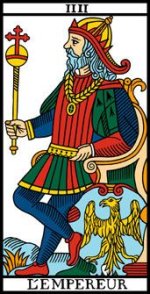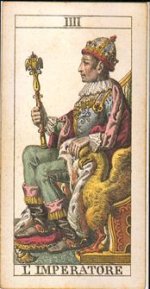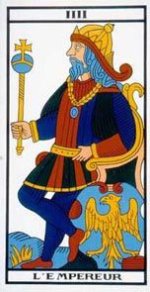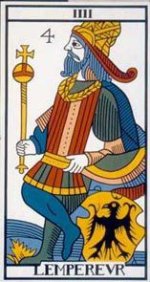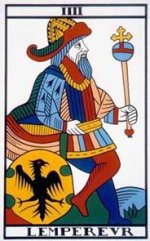catboxer
IV L'Empereur
A close look at early tarot decks, including early Marseilles decks, leads to the conclusion that the standard iconography of this card which we see today was a fairly late development. In particular, the representation of the Emperor as fully armored is of recent vintage. Whether his association with Aires is also a late development is open to discussion and debate. What seems certain is that there was from the first an association of this image with the kings and knights of the Arthurian legends, even if that association was tenuous.
In 1446 Bembo did 289 pencil illustrations for a manuscript entitled "The Story of Lancelot and the Lake," by the Italian writer Zuliano de Anzoli (see Kaplan II, pps. 123-eight), which is currently housed in the Biblioteca Nazionale of Florence and catalogued as the Codex Palatino 556. Bembo later outlined and finished his pencil sketches with black ink. Many of the images he invented for this book were later re-cycled into the Visconti-Sforza deck, including Love, the Old Man (Hermit), Il Matto (Fool), and the Emperor, as well as various court card pictures.
Folio 159 of the Codex shows two representations of the knight Tristan and two female figures in front of an unidentified king. Kaplan says he is probably King Dinas-Bran, a shadowy Welsh monarch of the dark ages who built a foreboding-looking castle on an isolated hilltop. In Bembo's picture he is shown in half-profile and wears the same hat, gown, and shoes as the Visconti-Sforza Emperor. The tarot card's Emperor faces the opposite way, (left rather than right), has the Imperial eagle on his hat, wears gloves, and holds an orb, but otherwise the pictures are very close to identical.
Only with the advent of the early Marseilles decks do we see the familiar image of the Emperor sitting in profile with his legs crossed, orb and sceptre in hand. Even then, he wears no armor (if I'm wrong about this, please correct me) until the 18th century, when Claude Thomasset's card shows him wearing what appear to be a breastplate and metal helmet. Also, his orientation in the various Marseilles decks is inconsistent; sometimes he faces one way, sometimes the other. Many people who favor systematic esoteric interpretations of the cards often put great stock in the Emperor's facing his right (our left) in modern decks.
Personally, as I understand this card, I prefer seeing the Emperor in armor. To me he represents discipline, order, rules, hierarchy, and a systematic, sometimes rather harsh approach to life. Like the Magician, this is a card that has both positive and negative aspects. Discipline and order are necessary in our lives, otherwise they'd lapse into chaos and anarchy. But too much discipline, too much order, too many rules, can cut us off from all spontaneity and intuitution. People afflicted with an over-reliance on order tend to cut themselves off from the ebb and flow of real life and live relationships, like a person encased in armor.
Question: at what point did the shield's emblem, the Imperial eagle, get replaced by the ram's head of Aires? With the BOTA deck, perhaps? Or with one of the French occult decks?
(Catboxer)
A close look at early tarot decks, including early Marseilles decks, leads to the conclusion that the standard iconography of this card which we see today was a fairly late development. In particular, the representation of the Emperor as fully armored is of recent vintage. Whether his association with Aires is also a late development is open to discussion and debate. What seems certain is that there was from the first an association of this image with the kings and knights of the Arthurian legends, even if that association was tenuous.
In 1446 Bembo did 289 pencil illustrations for a manuscript entitled "The Story of Lancelot and the Lake," by the Italian writer Zuliano de Anzoli (see Kaplan II, pps. 123-eight), which is currently housed in the Biblioteca Nazionale of Florence and catalogued as the Codex Palatino 556. Bembo later outlined and finished his pencil sketches with black ink. Many of the images he invented for this book were later re-cycled into the Visconti-Sforza deck, including Love, the Old Man (Hermit), Il Matto (Fool), and the Emperor, as well as various court card pictures.
Folio 159 of the Codex shows two representations of the knight Tristan and two female figures in front of an unidentified king. Kaplan says he is probably King Dinas-Bran, a shadowy Welsh monarch of the dark ages who built a foreboding-looking castle on an isolated hilltop. In Bembo's picture he is shown in half-profile and wears the same hat, gown, and shoes as the Visconti-Sforza Emperor. The tarot card's Emperor faces the opposite way, (left rather than right), has the Imperial eagle on his hat, wears gloves, and holds an orb, but otherwise the pictures are very close to identical.
Only with the advent of the early Marseilles decks do we see the familiar image of the Emperor sitting in profile with his legs crossed, orb and sceptre in hand. Even then, he wears no armor (if I'm wrong about this, please correct me) until the 18th century, when Claude Thomasset's card shows him wearing what appear to be a breastplate and metal helmet. Also, his orientation in the various Marseilles decks is inconsistent; sometimes he faces one way, sometimes the other. Many people who favor systematic esoteric interpretations of the cards often put great stock in the Emperor's facing his right (our left) in modern decks.
Personally, as I understand this card, I prefer seeing the Emperor in armor. To me he represents discipline, order, rules, hierarchy, and a systematic, sometimes rather harsh approach to life. Like the Magician, this is a card that has both positive and negative aspects. Discipline and order are necessary in our lives, otherwise they'd lapse into chaos and anarchy. But too much discipline, too much order, too many rules, can cut us off from all spontaneity and intuitution. People afflicted with an over-reliance on order tend to cut themselves off from the ebb and flow of real life and live relationships, like a person encased in armor.
Question: at what point did the shield's emblem, the Imperial eagle, get replaced by the ram's head of Aires? With the BOTA deck, perhaps? Or with one of the French occult decks?
(Catboxer)

